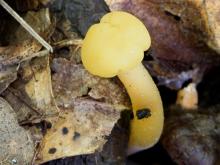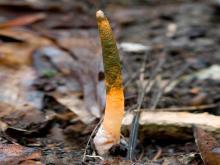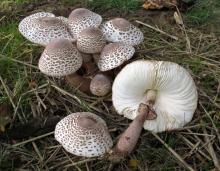Mushrooms
Media

Species Types
Scientific Name
Cantharellus lateritius
Description
The smooth chanterelle has a bright orange to yellow cap, wavy margins, and is smooth on the underside. It grows singly or in large groups in the soil.
Media

Species Types
Scientific Name
Hydnum repandum (Dentinum repandum)
Description
The hedgehog mushroom has an irregularly shaped, dull orangish tan cap, with spines or "teeth" on its underside. It grows on the ground in mixed woods.
Media

Species Types
Scientific Name
Artomyces pyxidatus (formerly Clavicorona pyxidata)
Description
The crown-tipped coral is a many-branched, coral-like mushroom that is yellowish tan with crownlike tips. It grows on the dead wood of deciduous trees.
Media

Species Types
Scientific Name
Leotia lubrica
Description
The jelly baby is a small mushroom with a gelatinous, orangish yellow stalk and head. It grows in groups on soil in mixed woods.
Media

Species Types
Scientific Name
Polyporus badius
Description
The black-footed polypore has a smooth, wavy brown cap with whitish or tannish pores on the underside and a black, smooth, off-center stalk. It grows singly or in groups of up to several on dead wood and stumps of deciduous trees.
Media

Species Types
Scientific Name
Mutinus elegans
Description
The elegant stinkhorn is a long, tapered, pinkish orange column with a greenish brown, smelly slime covering the top and a white cup around the base. It grows on leafy debris, mulch piles, and rotting wood.
Media

Species Types
Scientific Name
Laetiporus cincinnatus
Description
Pale chicken of the woods has layered, fan-shaped, fleshy caps that are orange to pinkish orange on top and white below. This edible fungus grows in overlapping clusters or rosettes on stumps, trunks, and logs of dead or dying deciduous trees, and on living trees and buried roots.
Media

Species Types
Scientific Name
Leucoagaricus americanus (Lepiota americana)
Description
The reddening lepiota is a large, reddish brown mushroom with a scaly cap and a ring on the stalk; it bruises dark red. It grows singly or in clusters in mulch piles, waste areas, and around stumps.
Media

Species Types
Scientific Name
Amanita spp. (about 600 species, worldwide)
Description
This large group of mushrooms accounts for 90 percent of mushroom-related deaths, so every mushroom hunter should be familiar with amanitas. They contain one of the deadliest poisons found in nature!
Media

Species Types
Scientific Name
Gymnopilus junonius (formerly G. spectabilis)
Description
Big laughing gym mushrooms are large, orangish yellow, and have a ring on the stalk. They grow in clusters on stumps and trunks of deciduous trees, on the ground, or over buried wood.
See Also



Media

Species Types
Scientific Name
Monotropa hypopitys
Description
Pinesap is a plant that puts the "wild" in wildflower! It lacks chlorophyll, so its roots connect to fungi underground and absorb nutrients from the fungi.
Media

Species Types
Scientific Name
Cladophora, Pithophora, and Spirogyra spp., and others
Description
Filamentous green algae forms green, cottony masses that are free-floating or attached to rocks, debris, or other plants.
Media

Species Types
Scientific Name
Monotropa uniflora
Description
Indian pipe lacks chlorophyll, so it is white, not green. Below ground, its roots join with fungi that connect to tree roots. This plant, then, takes nourishment indirectly from the trees.
About Mushrooms in Missouri
Mushrooms are a lot like plants, but they lack chlorophyll and have to take nutrients from other materials. Mushrooms are neither plants nor animals. They are in a different kingdom — the fungi. Fungi include the familiar mushroom-forming species, plus the yeasts, molds, smuts, and rusts.
Always be cautious when eating edible mushrooms. Be absolutely sure of the ID, and only eat a small amount the first time you try it to avoid a reaction..





















